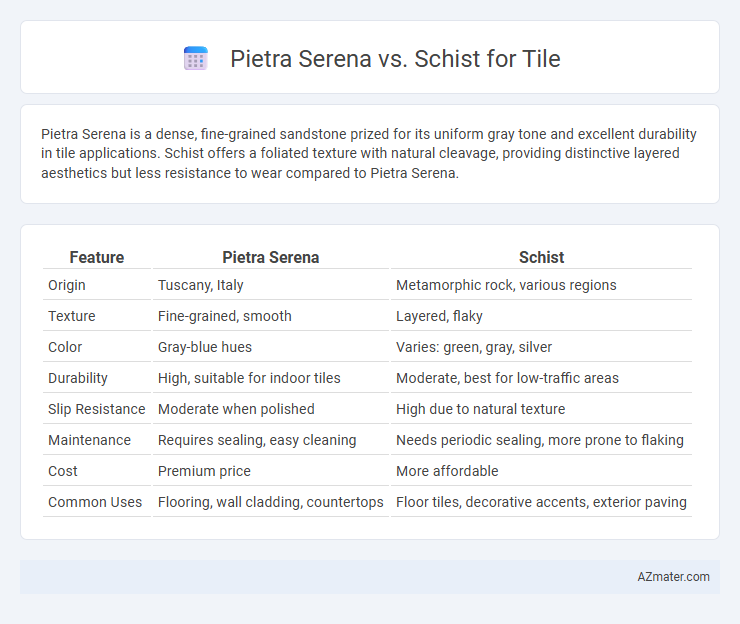Pietra Serena is a dense, fine-grained sandstone prized for its uniform gray tone and excellent durability in tile applications. Schist offers a foliated texture with natural cleavage, providing distinctive layered aesthetics but less resistance to wear compared to Pietra Serena.
Table of Comparison
| Feature | Pietra Serena | Schist |
|---|---|---|
| Origin | Tuscany, Italy | Metamorphic rock, various regions |
| Texture | Fine-grained, smooth | Layered, flaky |
| Color | Gray-blue hues | Varies: green, gray, silver |
| Durability | High, suitable for indoor tiles | Moderate, best for low-traffic areas |
| Slip Resistance | Moderate when polished | High due to natural texture |
| Maintenance | Requires sealing, easy cleaning | Needs periodic sealing, more prone to flaking |
| Cost | Premium price | More affordable |
| Common Uses | Flooring, wall cladding, countertops | Floor tiles, decorative accents, exterior paving |
Introduction to Pietra Serena and Schist
Pietra Serena is a fine-grained, blue-gray sandstone primarily quarried in Tuscany, Italy, prized for its smooth texture and uniform color, making it ideal for elegant architectural tiles and interior design. Schist is a metamorphic rock characterized by its foliated texture and pronounced mineral layering, often exhibiting earthy tones and a rugged, natural look favored for rustic wall and floor tiles. Both materials offer durability and aesthetic appeal but differ significantly in composition and visual style, influencing their suitability for various tile applications.
Geological Origins and Composition
Pietra Serena is a fine-grained sandstone originating from the Renaissance quarries of Tuscany, primarily composed of quartz, feldspar, and a high percentage of clay minerals giving it a distinctive blue-grey hue. Schist is a foliated metamorphic rock formed under intense heat and pressure, characterized by its layered structure and predominant minerals such as mica, quartz, and chlorite, resulting in a more variable color palette. The geological origins of Pietra Serena as a sedimentary rock contrast with Schist's metamorphic formation, influencing their durability, texture, and suitability for tile applications.
Visual Characteristics and Color Variations
Pietra Serena features a smooth, fine-grained texture with a consistent gray-blue hue, making it ideal for sleek, modern tile designs with subtle tonal variations. Schist exhibits a layered, foliated texture with a broader color spectrum, ranging from silvery gray to greenish and sometimes reddish tones, adding dynamic depth and natural variation to tile surfaces. The choice between Pietra Serena and Schist tiles depends on the desired aesthetic, with Pietra Serena offering uniformity and Schist providing rich visual complexity.
Durability and Performance as Tile
Pietra Serena offers exceptional durability with its dense, fine-grained structure that resists wear and maintains strength under heavy foot traffic, making it ideal for high-performance tile applications. Schist, characterized by its foliated texture, provides moderate durability but can be prone to flaking and fracturing, reducing its long-term performance as a tile. When selecting materials for tile use, Pietra Serena is superior in withstanding mechanical stress and environmental exposure, ensuring longevity and consistent performance.
Installation Techniques and Considerations
Pietra Serena requires careful handling during installation due to its fine-grained, dense nature, often necessitating professional cutting tools to prevent chipping. Schist tiles, characterized by their foliated structure, demand attention to orientation and natural cleavage planes to ensure durability and aesthetic consistency. Both materials benefit from proper substrate preparation and sealing, though Schist's layered composition may require additional moisture barriers to prevent delamination.
Maintenance and Cleaning Requirements
Pietra Serena tiles require regular dusting and gentle cleaning with pH-neutral detergents to maintain their smooth surface and prevent staining, while avoiding abrasive materials that can scratch the stone. Schist tiles demand more frequent sealing due to their natural cleft surface, which is prone to absorbing moisture and dirt, necessitating specialized stone cleaners to preserve texture and prevent discoloration. Both materials benefit from prompt spill cleanup, but Schist's layered structure makes it slightly higher in maintenance compared to the denser and more uniform Pietra Serena.
Cost Comparison and Availability
Pietra Serena tiles typically cost more than schist due to their refined texture and limited quarry sources, influencing overall project budgets. Schist tiles are generally more affordable and widely available because of larger deposits and easier extraction methods. Availability of Pietra Serena is mostly region-specific to Tuscany, Italy, while schist is commonly sourced from multiple global locations, enhancing accessibility.
Design Applications and Aesthetic Appeal
Pietra Serena offers a refined, soft gray tone with subtle veining, making it ideal for modern and minimalist tile designs that emphasize elegance and understated luxury. Schist, characterized by its foliated texture and rich, variegated colors, provides a dramatic, natural aesthetic well-suited for rustic or organic-inspired interiors. Both stones enhance spaces with unique visual textures; Pietra Serena delivers smooth sophistication while Schist introduces dynamic earthiness and depth.
Environmental Impact and Sustainability
Pietra Serena, a dense volcanic sandstone, offers lower environmental impact due to its natural durability and minimal processing requirements compared to schist, which demands more intensive quarrying and treatment. Schist's flaky, layered structure often results in higher waste generation and energy consumption during extraction and finishing. Selecting Pietra Serena for tiles supports sustainability efforts by reducing carbon emissions and resource depletion associated with tile production.
Choosing the Right Stone Tile for Your Project
Pietra Serena, a fine-grained blue-gray sandstone from Tuscany, offers a smooth texture and elegant appearance ideal for sophisticated interior spaces, while schist provides a foliated, layered structure with natural cleavage, making it highly durable and slip-resistant for both indoor and outdoor use. When choosing between Pietra Serena and schist for your tile project, consider the desired aesthetic, moisture exposure, and foot traffic; Pietra Serena excels in polished finishes for low-moisture environments, whereas schist withstands harsh conditions and heavy wear efficiently. Cost, maintenance requirements, and installation complexity also play crucial roles, as Pietra Serena typically demands professional sealing and gentle cleaning, contrasting with schist's rugged resilience and low upkeep.

Infographic: Pietra Serena vs Schist for Tile
 azmater.com
azmater.com